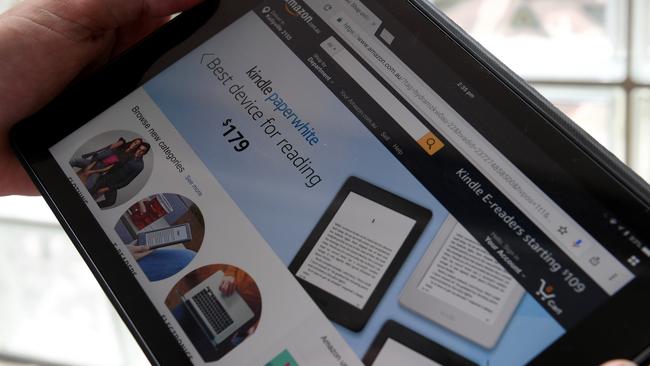Amazon Australia launch underwhelming, Terry McCrann writes, but for how long?
AMAZON, Shmamazon — or perhaps, more accurately, Shamazon. Amazon Downunder hit the ground not so much running as flop, flop, flopping, like a saturated tea towel. But for how long, asks Terry McCrann.

Terry McCrann
Don't miss out on the headlines from Terry McCrann. Followed categories will be added to My News.
AMAZON, Shmamazon — or perhaps, more accurately, Shamazon.
Amazon Downunder hit the ground not so much running as flop, flop, flopping, like a saturated tea towel and most definitely not an agile speedster.
On Day One it completely failed to live up to both the hype and, more potently, the fear and loathing.
AMAZON COUNTS COST OF LOCAL COMPETITION
WHY AMAZON AUSTRALIA FAILS TO LIVE UP TO EXPECTATIONS
AMAZON LAUNCHES AUSTRALIAN SITE
Sure, it offered a vast array of utterly bland, retail store-priced product, with some equally uninspiring discounts that would have prompted Iocal retailers to ask: is that all there is, Jeff?
Indeed, what does it say about the “offer”, when a colleague identified, via a couple of clicks, an Amazon-branded product — to stress, not another brand or a generic, but an Amazon Kindle — selling cheaper in an actual clunky Aussie bricks-and-mortar store.

For those, including the present writer who uses the real Amazon quite a lot — mostly for product that is simply not available down under — the local site ain’t going to change that anytime soon.
The product line looks like more of the same stuff that sent me to Amazon America in the first place and the pricing was decidedly unpersuasive.
In one of those “interesting” conjunctions, this coincided with good monthly retail figures and the local retail stocks defied the broader negative market tone and mostly closed higher.
To me, there are two big conflicting messages out of Day One. One is somewhat comforting for local retailers and especially bricks-and-mortar ones. But the other is a very big warning.
The first message is that the — especially US resident — “Amazon model” doesn’t translate easily, far less seamlessly, down under. It ain’t automatically a bricks-and-mortar crusher.
The big brick wall Amazon hit is our cost structure. It couldn’t bring its low — especially wages — cost structure down under. And yesterday at least it was trying to compensate for that with a focused (Woolies and Coles, and Myer and DJs) selective branded discounts tactic rather than the Aldi “all-store cheaper” version.
But that leads me to the very big warning. At the macro level, what matters — not just for Amazon and its retail competitors, but also, very importantly, suppliers — is not Day One, but Day Two and thereafter.
This is not like a new TV series, where if you don’t get the eyeballs on Day One you are pretty much cooked.
Amazon’s here for the long game and it’s one where it chases revenues not profits — both of which it demonstrated in spades over decades in the US.
Then there’s size. Woolies and Wesfarmers have a total market cap between them of around $85 billion. Add on Myer and DJs and that number hardly changes.
Add on other big retailers and you get somewhere over $100 billion.
Amazon is over $700 billion. Now obviously, it’s not going to throw all that at Australia. But it has a lot of heft and also the unique advantage of integrating its two offers — the local one and the US one — as it develops a feel for the dynamics and quirks of the local market.
Further, arguably, it will start to get its Australian cost base down thanks to robotics, something which the bricks-and-mortar retailers will find tough to match.

And then there’s the suppliers. On Day One, judging by its pricing, Amazon has played a pretty conventional game — writing conventional wholesale supply deals and then adding some sort of retail or Amazon margin.
That is not going to last. You want to facilitate sales through the Amazon marketplace, you are going to have to supply at a cheaper price and, over time, arguably a grindingly cheaper price.
Either to keep Amazon happy, as even the big guys have found in dealing with Woolies and Coles with increasing intensity over the last ten to 15 years; or to get your price competitive against a multitude of alternative supplies coming from “competitors” you previously didn’t know you had and probably didn’t have, in real terms.
Getting space on supermarket shelves has proved brutal enough; getting on to that first page on the Amazon website; and not just the first page but among the first few items on the page, is going to take brutality to a new peak.
Amazon came, saw and didn’t conquer. But if I were in retail or selling into retail, I’d read that as a very big warning light, flashing fire-engine red.
THE RBA, RATES & RC
THE Reserve Bank left interest rates unchanged again yesterday. It’s now off to its break. It “comes back” at the start of February.
It will then have the December quarter inflation figures to look at.
But absent some global shock or some dramatic local shift (and no, I do not mean a Goldilocks midyear Budget update and promised tax cuts) yesterday will be repeated, word for word.
This is a very desirable thing. Not only does it tell you that the Aussie economy is ticking over pretty well (again, no, not perfect, and not everybody will be happy), but you really do not want the uncertainty that will come when and if the RBA commits to changing its rate.
This does not mean you won’t see changes in actual rates. As Westpac showed, on one side when it cut some of its fixed-rate loan rates.
But also, potentially, if we see banks having to lift their lending rates as they find they have to pay more in global financial markets for the 40 per cent of so of their money that they borrow there.
For those who cheered the royal commission, let’s hope you don’t end up paying too hefty a price in terms of higher mortgage rates for the pleasure.
Although the banks have overstated the fear and loathing that might develop — over there.


